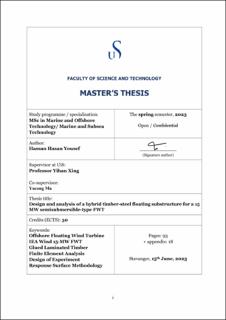| dc.description.abstract | Wind energy has developed to be among the most promising sources of renewable energy. Furthermore, floating offshore wind turbines have presented the opportunity for higher power production in intermediate (45-150 m) and deep water (> 150 m). However, the manufacturing, installation, and operation of wind turbines in general, and floating wind turbines in particular, can result in significant amounts of greenhouse gas emissions (GHG).
This thesis proposes a novel design of a hybrid timber-steel floating substructure for the IEA 15 MW floating wind turbine. The new design presents a modified version of the UMaine VolturnUS-S semisubmersible platform that was initially developed for the same turbine. The main objective of the new design is to reduce the turbine’s overall CO2 footprint. This objective is achieved by replacing structural steel with glued laminated timber, a more sustainable material known for its environmental benefits.
Firstly, a robust design methodology is introduced. Secondly, Ansys workbench 2020 R1 is utilized to compare and then select between three preliminary hybrid timber-steel models based on a set of criteria that are extracted from relevant standards for both timber and steel. Compared to the UMaine VolturnUS-S semisubmersible platform, the selected hybrid configuration provides a considerable reduction in the steel mass (around 590 t). Subsequently, fully coupled aero-hydro-servo-elastic dynamic analysis is carried out using OpenFAST to validate the selected model. Only the ultimate limit state design (ULS) for the turbine under extreme and normal operating conditions is considered. The results from the numerical analysis show that the selected model fulfills all design criteria with a utilization factor that varies between 74- 94% for the different design load cases. In the end, the work concludes that the glulam-based supporting structure offers an effective load-bearing solution for the IEA 15 MW turbine, contributing to the development of floating wind energy with minimal cost and CO2 footprint. However, a series of tasks and suggestions are proposed to enhance the process of developing an optimal timber-steel design. | |
